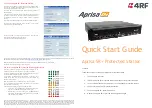
STATUS ANNUNCIATORS
These are small symbols that appear on the display
indicating the status of certain radio functions.
GENERAL FEATURES
Status (Trunking Systems Only)
Selecting Transmit Power Level
Sending an Emergency Alarm
Sending a Silent Emergency Alarm
Cancelling an Emergency Alarm
Sending an Emergency Call
Failsoft Operation (Trunked Systems Only)
Carrier Squelch
(
C
)
Indicates carrier squelch is open to
monitor all active conventional mode
traffic. When not displayed, traffic is not
open to monitoring.
Secure
Operation (
D
)
(Secure radios
only)
When solid, radio is transmitting
securely.
When flashing, radio is receiving
securely.
When off, radio is operating in clear
mode.
Call Received
(
F
)
Flashes when a Private Call, page, or
Phone Call is received.
Scan (
G
)
When displayed, indicates the radio is
scanning.
Priority Scan
(
H
)
Indicates scanning of a priority mode
(flashing for Priority 1 mode; solid for
Priority 2 mode).
RSSI
M
Radio Signal Strength.
Programming/
View Mode
(
I
)
When solid, radio is in view mode.
When flashing, radio is in programming
mode.
Direct (
J
)
When on, indicates you are talking
directly to another radio (talkaround).
When off, you are talking through a
repeater.
Tx Power Level
(
R
)
Transmission power of the radio is low.
PPP Link
Establishment
Indicates that the subscriber is ready to
receive data through a data cable.
Packet
Data
activity
Indicates the subscriber is transmiting
and receiving data.
Packet
Data IP
Indicates the subscriber is ready to
access the FNE ***.
1 Press
STS
. The display shows the last acknowledged
status or first status name.
2 Rotate the
Mode
knob to select the desired status.
3 Press the
PTT
button to transmit the selected status.
4 Press the
EXIT
softkey to exit status and return to the
home display.
1 Press
m
below
PWR
.
The display shows
HIGH PWR
or
LOW PWR
..
2 If
HIGH PWR
was selected previously, pressing the
softkey will display
LOW PWR
and the low power
indicators are turned on.
3 If
LOW PWR
was selected previously, pressing the
softkey will display
HIGH PWR
and the low power
indicators are turned off.
Press and hold the preprogrammed emergency button
(
T1
).The red LED lights steadily. You hear an emergency
tone. The display alternately shows
EMERGNCY
and the
current zone and mode names. When the alarm is
acknowledged by the dispatcher, you hear four beeps.
The radio returns to normal operation.
Press and hold the preprogrammed emergency button
(
T1
). The radio transmits the emergency without any
external indication than an alarm is in progress.
Press and hold the preprogrammed emergency button
(
T1
) before the alarm is acknowledged.
You hear an exit tone and the radio returns to normal
operation. If the radio does not return to normal
operation, press the
PTT
button. The radio does NOT
sound an exit tone.
1 Press and hold the preprogrammed emergency
button (
T1
).The red LED lights steadily. You hear a
short, medium-pitched emergency tone. The display
alternately shows
EMERGNCY
and the current zone
and mode names.
2 Press the
PTT
button and announce your emergency.
3 To exit emergency call mode, press the emergency
button for a little over 1-1/2 seconds (or for the
duration specified by your system manager).
You hear a medium-pitched exit tone and the radio
returns to normal operation
During Failsoft operation, you hear a faint beeping tone
every ten seconds. The radio unsquelches. The display
alternately shows
FAILSOFT
and the current trunked
mode name.
Summary of Contents for Astro XTL 1500
Page 1: ...User s Guide ASTRO XTL 1500 Digital Mobile Radio ...
Page 2: ......
Page 8: ......
Page 16: ...ix Notes ...
Page 30: ...14 Getting to Know Your Radio Notes ...
Page 38: ...22 Basic Radio Operation Notes ...
Page 68: ...52 Conventional Features Notes ...
Page 94: ...78 Troubleshooting Notes ...
Page 104: ...88 Glossary Notes ...
Page 110: ...94 Commercial Warranty and Service Notes ...
Page 116: ......
Page 118: ......
Page 119: ......
Page 120: ......





































